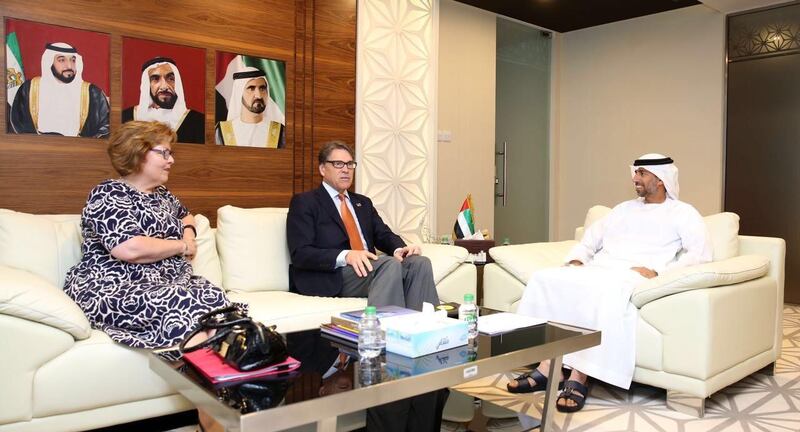Energy heads from the UAE and United States discussed further collaboration, including the possibility of liquefied natural gas imports from the North American country.
The UAE energy minister and 2018 Opec president, Suhail Al Mazrouei, met with Rick Perry, the US energy secretary, on Tuesday to “move forward joint cooperative efforts”.
“The two ministers noted that the growing US LNG exports could provide an option for an additional source of gas supply to the region,” the UAE energy ministry said in a statement. This comes after Mr Perry's visit to Saudi Arabia where the countries signed a memorandum of understanding for clean fossil fuels and carbon management.
Good to see and hear from our business and industry friends here in UAE. Thanks for the productive discussions and continued support in the #energy industry #innovation pic.twitter.com/iBtLr56tEV
— Rick Perry (@SecretaryPerry) December 5, 2017
The UAE is a pipeline natural gas net importer while being an LNG exporter. The country has a substantial amount of proved natural gas reserves, but it has a high sulfuric content which makes it difficult and expensive to extract.
The country has been turning to LNG imports to help meet demand, which has also been helped with the sharp decline in the resource’s price seen over the summer.
S&P Global Platts’ Japan Korea Market (JKM), the value of spot cargo delivered to the traditionally premium northeast Asian market, over the summer halved in two years to $6 from US$14 per million British thermal units (btu). While current spot rates are at three-year highs as a result of strong seasonal demand, more supplies are expected to flood into the market with new additions from countries such as Egypt and ramp up efforts from Australia.
______________
Read more:
Egypt will focus on deepwater gas finds
_______________
Some US LNG has already been making its way to the UAE as Houston-based Cheniere Energy began sending cargoes to Dubai last year. UAE imports are expected to increase thanks to the delivery of the country’s second floating storage and regasification unit in Abu Dhabi, which helps reconvert the fuel quicker and at a cheaper cost than onshore facilities. And a third import terminal is expected to be installed in Sharjah next year.
S&P Global Platts said in a report earlier this year that the number of countries that supply LNG to the Middle East has more than doubled to 19 last year from only nine in 2014.
Natural gas is the driver for the UAE’s primary energy consumption, helping to generate electricity as well as desalination. Between 2014 and 2015, the country’s power consumption increased 7 per cent and could grow by 50 per cent by 2020, according to the US International Trade Administration.
The meeting between Mr Al Mazrouei and Mr Perry also focused on the cooperation to help execute the UAE Clean Energy 2050 plan, which targets a diversified energy energy strategy including 44 per cent from renewables, 38 per cent from gas, 12 per cent from clean fossil (such as clean coal) and 6 per cent from nuclear energy.






